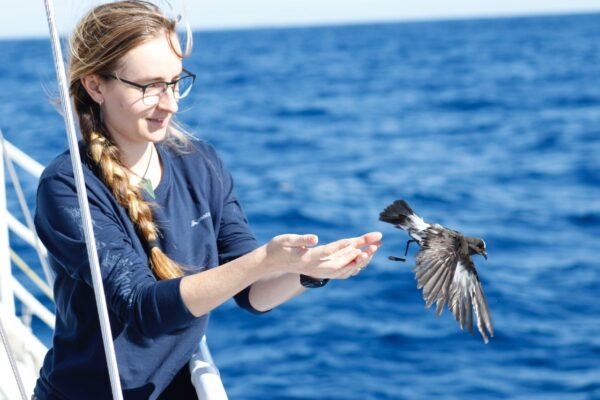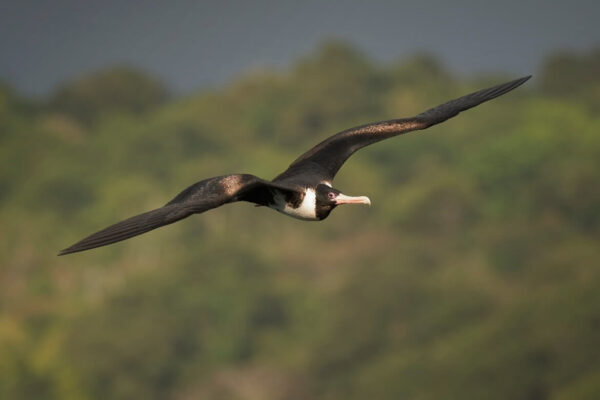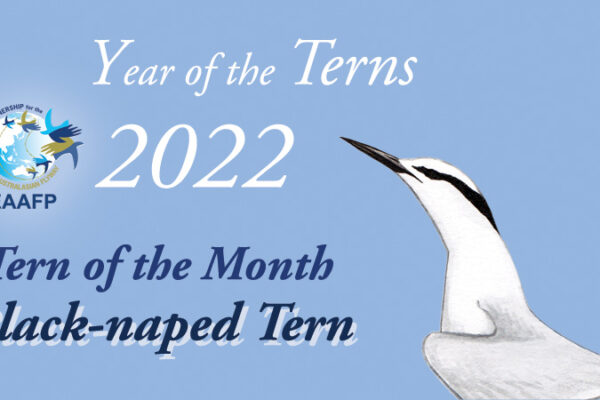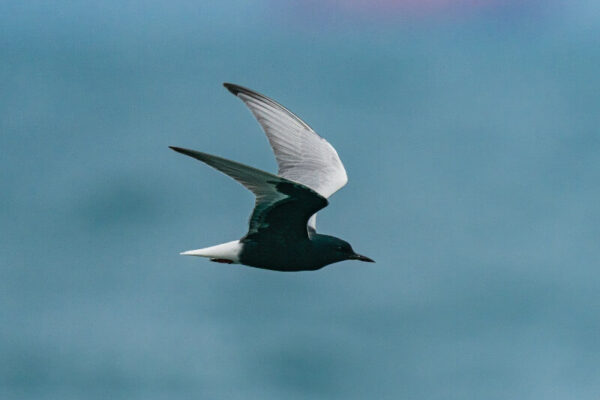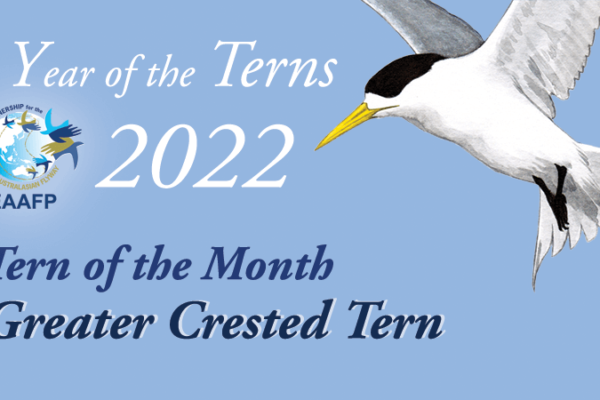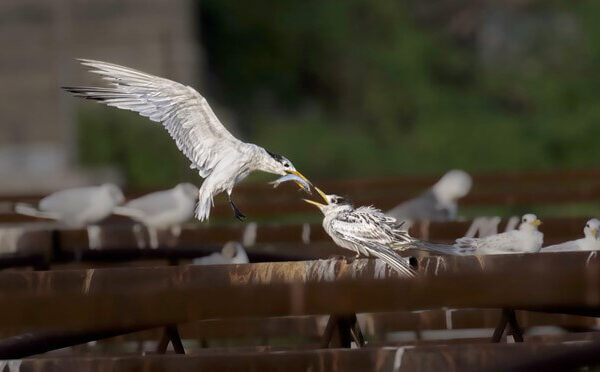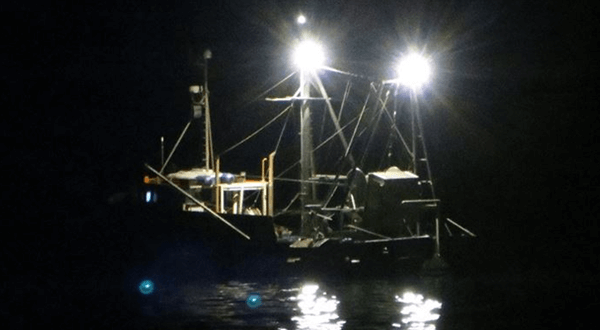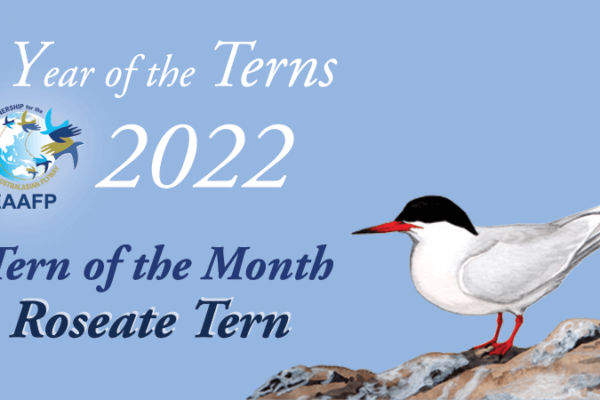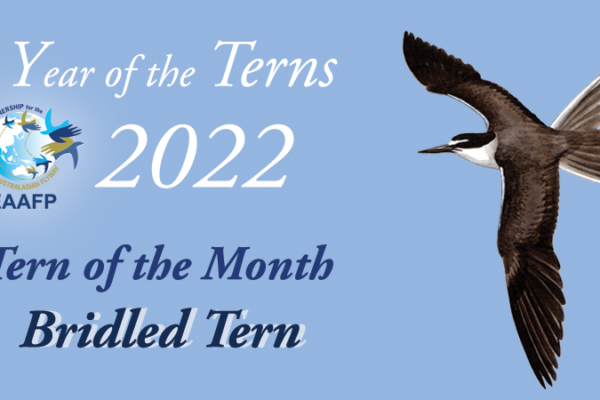-
“Year of the Terns” Flyway Story Series #18 – Interview with Ms. Edin Whitehead
As EAAFP is designating 2022 the “Year of the Terns,” we are bringing great work and stories on tern conservation to you. The next story is from Ms. Edin Whitehead, who is a seabird scientist and conservation photographer in Aotearoa New Zealand. She was also a judge of the Year of the Terns Photo Contest (link). Photo of her releasing a New Zealand storm petrel @Jochen Zaeschmar EAAFP: Hello Edin, first of all, thank you once again for your effort as a judge to the Year of the Terns Photo Contest. Before we go deep, could you please tell us a little bit about yourself and your background? What brought you to studying seabirds and become a conservation photographer? Two things have always been constant in my life - a love of the outside world, particularly birds, and a love of creating. I started out sketching and painting, and eventually started joining my Dad on birdwatching trips that have morphed into bird photography trips over the years. It’s something we both love to do. I actually started studying Fine Art at university before switching to biology – so I could go on field trips around Aotearoa! I fell in love with seabirds – particularly petrels and albatrosses – after going to sea for the first time. The science and photography parts of my life have just started to combine into a career, and I value being able to use my photographs to share seabird science stories, and advocate for their conservation. EAAFP: We heard that you have recently released a book, Brilliance of Birds. Could you please introduce it to our audience and are there any highlights you would like to share? The Brilliance of Birds was published in 2019 by Penguin Random House New Zealand. It was a collaborative project between me and Skye Wishart, and we like to call it a bit of a celebration of some of the unique bird species that call Aotearoa home. There’s a mix of native and endemic species, as well as some of the introduced ones that people see every day, and we tell stories about their behaviours and biology, as well as their histories and cultural importance. I had so much fun working on the photographs for that book – I spent a year travelling around the country on ‘birdventures’ to meet species I’d never seen before. One of my most special memories from that time was photographing tarapirohe – Black-fronted terns – in the early spring snow in the Eglinton Valley in Fiordland. EAAFP: We found that you have also prepared a report on “Threats to Seabirds of Northern Aotearoa New Zealand” could you share with us the background on why this report was prepared and the processes behind it? Additionally, do you have any key messages from the report you would like to share? Seabirds are the most threatened group of birds in the world, and for well-targeted local conservation management, it’s important to understand which threats are most impacting the birds in your region. The report was put together to collate all the information we had for seabirds in the Northern Aotearoa region, and highlight the knowledge gaps about seabird biology and threats to seabirds that needed to be filled. It has since spurred a number of research projects, which is great. I think one of the key messages from the report was that we need to consider the whole ecosystem when doing conservation management – there’s no point in trying to restore seabird populations on land by controlling predator species if there’s no food in the marine habitat to sustain them. EAAFP: What was the most memorable moment during your expeditions? That’s a difficult question! One of my favourite research expeditions in the past few years was volunteering on a project catching New Zealand storm petrel at sea for a genomics study – to understand if there might be hidden populations on different islands. At the moment, Te Hauturu-o-Toi (Little Barrier Island) is the only place they’re known to breed. Capturing these tiny birds at sea is really tricky! It was hard work, and we would work into the evening if the conditions were calm enough. One evening the sea was like a mirror, and being out in the dinghy to catch the birds was like floating inside a huge prism of pinks and purples, with these tiny black-and-white birds dipping along the surface. There were a few Antipodean albatrosses cruising past as well. I took lots of photographs, but none of them really do justice to how beautiful it was. We caught one last bird just after the sun had set. Storm petrel at sea @Edin Whitehead EAAFP: On your webpage it says you “combine science and storytelling to help people explore our natural world” could you share with us an example of one of these stories? One of my long-term projects is to illustrate and share the lives of the seabirds that live around northern Aotearoa – particularly in Tīkapa Moana, the Hauraki Gulf. There are 27 species of seabirds that breed here, and many of them are species that people will never see unless they go out on the water, sometimes quite far offshore. I want to share the wonder I have in this remarkable diversity, and get people excited about these birds – most people don’t even know that there is a species here that has come back from being thought extinct for over 100 years – the New Zealand storm petrel. I’ve been really lucky to be involved in some of the research on this beautiful little bird, so I get to share some of the behind-the-scenes of seabird science. It’s a topic I often speak on, and I even work it into my photography talks! EAAFP: As a conservation photographer, are there any tips or words of caution you would like to share with other photographers? I think in a world where photography seems to have morphed into a ‘content-creation’ craze on social media where people do anything for ‘likes’, it’s really important to look at what value your photography gives back to the ecosystems that you work in. Ethical wildlife photography, honesty in captioning, and advocating for conservation are all crucial to this. EAAFP: Seeing your online gallery, we see many photos of albatrosses, are they your favorite Seabird Species? Could you share about your favorite seabird? I do love albatrosses and petrels! Their lives fascinate me – how they live far out on the ocean and make huge migrations around the world. I find it hard to say I have one favourite species, but I do have a soft spot for tiny little storm petrels – like the New Zealand storm petrel or White-faced storm petrel. They live in the same wild seas that albatrosses do, but they’re so much smaller and I find their resilience truly remarkable. EAAFP: Lastly, we know you wear many hats as a Doctoral Candidate at the University of Auckland, a conservation photographer, a blogger, an explorer in expeditions and more. How do you balance everything? There is a lot of overlap! I spend time on my own research trips making photographs that I use to communicate conservation issues. Sometimes I do have to prioritise what is most important – my blog has fallen a bit quiet as I work on writing up my thesis at the moment. Grey-faced petrel in purple bag @ Chris Gaskin
Continue reading -
Conserving Critically Endangered Christmas Island Frigatebird
The Christmas Island Frigatebird (Fregata andrewsi) is a globally threatened migratory seabird; listed as Vulnerable by the International Union for the Conservation of Nature (IUCN). In Australia, the species…
Continue reading -
“Tackling Impact on Seabirds by Light Pollution at Sea” Webinar
Following the 2022 World Migratory Bird Day theme highlighting the impact of Light Pollution on…
Continue reading -
Black-naped Tern
Black-naped Tern ©Kenneth Lam Common Name: Black-naped Tern Scientific Name: Sterna sumatrana Local names: 黑枕燕鸥 (Simplified Chinese), 黑枕燕鷗 (traditional Chinese), 엘리 그로 제비갈매기 (Korean), エリグロアジサシ(Japanese), Dara laut Tengkuk Hitam (Indonesian), Camar Tengkuk Hitam (Malayu), Nhàn Sumatra (Vietnamese), นกนางนวลแกลบท้ายทอยดำ (Thai). IUCN status: Least Concern The Black-naped Tern is a small to medium-sized tern species, distributed mainly in Tropical Indian and Pacific Oceans. It has distinctive for its white plumage except with a black band from the eyes, which continues in broadening to the nape. It contains two subspecies: S.s. sumatrana and S.s. mathewsi. Identification Adult Black-naped Tern in Hong Kong ©Kenneth Lam Size: 30-35 cm; wingspan 61-66 cm. Breeding plumage: White body a distinctive black band from the eyes, continues in broadening to the nape Non-breeding plumage: Only the black band becomes paler and less defined Juveniles have a dusky cap but leave a white forehead, creating a masked look; upperwings heavily scaled with creamy edges. Beak: black Legs: black Distribution range The subspecies S.s. sumatrana in EAA Flyway region breeds Eastern to Southern Japan, China, then migrate to the south. Others resident or disperse locally in Malaysia, the Philippines, Indonesia and New Guinea, to Northeast and Eastern Australia and Pacific Southwest Pacific Islands. Habitat Breeding habitat Sand or coral islands, reeds, sand spits and rocky cays. Breeding habitat of Black-naped Tern in Hong Kong ©Kenneth Lam Non-breeding habitat Feeds in lagoons and close inshore over breakers, sometimes at sea. Behavior Black-naped Tern feeds on small fish and almost always forages singly by shallow plunge-diving or surface diving. Breeding colonies are small, and usually consist of 5-20 pairs but can be up to 200 pairs. Population estimate The global population has not been quantified. Main threats Human disturbance Invasive non-native/alien species/diseases Natural threats Flooding Conservation Work Conservation research of breeding terns in Hong Kong The Agriculture, Fisheries and Conservation Department (AFCD) of the Hong Kong Government and Hong Kong Bird Watching Society started conservation research on breeding terns in Hong Kong waters in 2018, with support from the Japan Fund for Global Environment (JFGE). The three species of terns breed in Hong Kong are Black-naped, Bridled and Roseate Terns. The flagged terns have the white flag on the right tibia and an engraved yellow flag on the right tarsus (see photo). (Read more: link) A flagged Black-naped Tern in Hong Kong ©Agriculture, Fisheries and Conservation Department (AFCD), HKSAR Fun Fact When facing predators, adults mob predators and may give plover-like “ungulate” displays with upright posture and spread wings to frighten the predators away. References IUCN Red List: https://www.iucnredlist.org/species/22694612/132561758 Birds of the World: https://birdsoftheworld.org/bow/species/blnter1/cur/introduction Seabirds: The New Identification Guideby Peter Harrison, Martin Perrow and Hans Larsson (Lynx Edicions, Barcelona, 2021). Projects on conserving breeding terns in Hong Kong: AFCD: https://www.eaaflyway.net/color-flagging-of-breeding-terns-in-hong-kong-2018/ HKBWS: https://cms.hkbws.org.hk/cms/en/hkbws/work/resarch/tern/tern2019e “Year of the Terns” Flyway Story Series #18 – Interview with Ms. Edin Whitehead Work and achievements of EAAFP Secretariat in collaboration with the Partners in 2022 Webinar on Chinese Crested Tern in the Yellow Sea and Seabird Conservation in China White-winged Tern Greater Crested Tern Winners of 2022 “Year of the Terns” Photo Contest Announced! Roseate Tern Bridled Tern Chinese Crested Tern banded in Republic of Korea sighted in China The Philippines conducts its 1st National Training on Seabird Identification and Monitoring
Continue reading -
White-winged Tern
White-winged tern ©Kenneth Lam Common name: White-winged Tern Scientific name: Chlidonias leucopterus Local names: Белокрылая крачка (Russian), 白翅浮鸥 (Simplified Chinese), 白翅浮鷗 (called in Hong Kong),白翅黑燕鷗(called in Taiwan) (traditional Chinese), 흰죽지제비갈매기 (Korean), ハジロクロハラアジサシ(Japanese), Dara laut sayap putih (Indonesian), Camar Bermisai (Malayu), Nhàn xám (Vietnamese), นกนางนวลแกลบดำปีกขาว(Thai). Also known as White-winged Black Tern. Conservation status: IUCN - Least Concern The White-winged Tern is a Eurasian species. Medium-sized, distinctive in breeding plumage with black head and body while white wing, rump and tail. As the species breeds inland, it adapts to various habitats from freshwater wetlands to coastal wetlands. Identification Size: 23-27 cm; wingspan 58-67 cm. Breeding plumage: Blackhead, body and scapulars Contrasting white and tail and greyish upper wing Non-breeding plumage: Black colour would fade and body become greyish on the body and upper wing Head turned white with dusky crown and ear-coverts patch Juveniles appear like non-breeding adults, but cap, wing and body feathers is blackish-brown, and upper wings are barred and ashy brown. Beak: red to black Legs: Reddish-black Distribution range Breeding range confined to Northern Hemisphere, from Central Europe to Russia reaching to Eastern China. Non-breeding range is towards the southern Hemisphere, including Africa, most of South and Southeast Asia, to New Guinea, Australia and New Zealand. The tern is vagrant to Alaska and elsewhere in the USA. Habitat Breeding habitat Unlike many tern species, White-winged Tern breeds mainly inland, on freshwater lakes and swamps, rivers, and flooded grassland with areas of open water. Non-breeding habitat Non-breeding on migration or winter at various habitats from inland lakes, rivers, flood plains to coastal rocky shores, lagoons and mangrove swamps. The bird is also found feeding over wet fields, farmland and steppe grassland. White-winged Tern roosting at the east coast of Aceh, Indonesia ©Qiran Altafunnisa Behavior White-winged Tern breeds at the age of 2. They breed in small colony from 3-100 pairs, but exhibit low site fidelity. The bird may skip breeding in drought years. Being inland breeders, the bird feed mainly on aquatic insects, sometimes terrestrial insects, and occasionally small fish or tadpoles. Population estimate Global estimated population: The global population is estimated to number c.3,100,000-4,000,000 individuals (Wetlands International 2015). East Asian-Australasian Flyway population is estimated c. 100,000 – 1,000,000 individuals (WPE5). Main threats Habitat destruction Water regulation (increasing drainage schemes) degrades the habitats Other threats Pollution (including plastic pollution) Feral dogs, cats and introduced predators such as raccoons and minks. Susceptible to avian influenza Conservation Work Although it is not highlighted as a specially protected species in any country because of its Least Concern status according to IUCN, it is a species not well-studied. Protection of inland wetland systems and removal of feral and invasive predators (such as dogs, and raccoons) to these sites will benefit its survival. Fun Fact Although breeding mostly in Northern Hemisphere, there were four breeding records in New Zealand from the lower Rakaia River (1917, 3 chicks fledged), Opihi River, South Canterbury (December-February 1973-74), upper Acheron River, Marlborough (December 2012), and near Twizel (January 2015). Its genus name Chlidonias is from Ancient Greek khelidonios, which means "swallow-like". In fact in many countries, terns are referred as ‘sea-swallows’ in local names. Hybridization with Black Tern (Chlidonias niger) has been recorded in Europe. References IUCN Red List: https://www.iucnredlist.org/species/22694730/154676367 Birds of the World: https://birdsoftheworld.org/bow/species/briter1/cur/introduction New Zealand Birds Online: https://nzbirdsonline.org.nz/species/white-winged-black-tern Australian Government Species Profile and Threats Database: https://www.environment.gov.au/cgi-bin/sprat/public/publicspecies.pl?taxon_id=59598 Gochang Big Bird Race 2023 brought birdwatchers to contribute bird data to the UNESCO World Heritage Site Special achievement award to the Chinese Crested Tern team Webinar on Chinese Crested Tern in the Yellow Sea and Seabird Conservation in China Chinese Crested Tern banded in Republic of Korea sighted in China Chinese Crested Tern Restoration of the Critically Endangered Chinese Crested Tern using social attraction technique A Conservation Success in Minjiang River Estuary A tern for the better Critically Endangered Chinese Crested Terns appear on a deserted island in South Korea The First Ever Banded Chinese Crested Tern Chick has Fledged
Continue reading -
Greater Crested Tern
Greater Crested Tern ©Kenneth Lam Common name: Greater Crested Tern Scientific name: Thalasseus bergii Local names:Крачка Берга (Russian), 大凤头燕鸥 (Simplified Chinese), 大鳳頭燕鷗 (traditional Chinese), 큰제비갈매기 (Korean), オオアジサシ(Japanese), Dara laut jambul besar (Indonesian), Camar Besar Berjambul (Malayu), Nhàn mào (Vietnamese), นกนางนวลแกลบหงอนใหญ่ (Thai). Also known as Swift Tern in Africa, and Crested Tern in Australia Conservation status: IUCN - Least Concern The Greater Crested Tern is a large-sized tern species distributed in tropical and subtropical Old World, usually nesting in dense colonies in coastal islands. There are four subspecies recognized: Thalasseus bergii bergii, Thalasseus bergii thalassinus, Thalasseus bergii velox, Thalasseus bergii cristatus, with T.b. cristatus found within the EAA Flyway. Identification Identification: Size: 43–53 cm; wingspan 100–130 cm. Body: Grey upper parts and white under parts. It has a distinctive white forehead, glossy black cap with a long crest, crest recedes in the non-breeding season Beak: Yellow Juvenile: Juveniles appear like non-breeding adults, with crown feathers brownish with pale spots, underparts and upper wings are barred and ashy brown. Distribution range Thalasseus bergii cristatus: Northern-most breeding range in Ryukyu Islands and southeastern China up to the Yangtze Estuary, all-year-round to the Philippines, Southeast Asia, the Sunda Islands, Wallacea, New Guinea, Australia, and the tropical Pacific Ocean (to southeastern Polynesia). Non-breeding movement is understudied. Satellite tracking showed those breeding in SE China winter in coastal Indo-China, Thailand, Myanmar and northern Philippines. Birds breeding at Paracel (Xisha) Islands in the South China Sea winter in central Philippines and Borneo. Non-breeding birds in Wallacea were mostly tracked to visit northern Australia where they may breed, with one tracked to Palau. Habitat Breeding habitat Nests on offshore islands, low-lying sandy, rocky or coral islets, usually unsheltered bare surface. The bird forages in shallow waters in estuaries, lagoons and barrier reefs, along beaches, and also in the open sea. They may take rest on buoys or sandbars. Breeding habitat of Greater Crested Tern in Zhejiang, China © Simba Chan Dense nesting colony of Greater Crested Tern in Zhejiang, China © Simba Chan Non-breeding habitat Greater Crested Tern wanders and disperses after the breeding season. They use sandy islands, coastal sandy or tidal flats. Greater Crested Tern resting on buoy ©Kenneth Lam Behavior Greater Crested Tern nest in dense breeding colonies, also highly vocal during breeding season. Colony size is depending on food abundance and habitat area. Largest colony can be up to 15,000 pairs. Although the bird nest in dense colony, but each pair establish small area of territory and they would peck any intruder bird in the territory. The male bird would perform courtship dance for female, with nuptial gifts, usually fish. Population estimate Global estimated population: The global population is estimated to number c.150,000-1,100,000. while regional population estimates in EAA Flyway are 100,000-1,000,000 according to the 1st Conservation Status Review. However, the estimation seemed to lump several populations together. From present knowledge the Greater Crested Tern breeding along the coasts of Zhejiang, Fujian, Taiwan and Guangdong are likely belonged to one population that migrates to Indo-china, Thailand, Myanmar and the northern Philippines. This population is probably around 30,000 birds with an increasing trend. Main threats Human disturbance, e.g. recreational and tourism activities in coastal areas close to breeding colonies Egg collection Habitat loss (Note: A regular migratory stop-over site for this species and many other terns and shorebirds, the tidal flat of Pamawaran, Bulacan in Manila Bay, the Philippines, is currently under threats from reclamation for airport expansion. Hundreds of Greater Crested Terns, including up to 10 individuals color-banded from Zhejiang and Taiwan, have been recorded at these sites since 2021.) GCT color-banded in Zhejiang, China sighed at Manila Bay, the Philippines on 28 October 2022 © Irene Dy Other threats: Pollution Plastic pollution Over-fishing Natural threats: Adverse weather conditions, e.g. typhoons, heavy rains, strong winds and waves Natural predators (e.g. gulls, Peregrine Falcon, snakes, rats) Conservation Work Satellite tracking study of Greater Crested Terns in collaboration with Indonesia shed light to conservation of Criticallty Endangered Chinese Crested Tern wintering ground Greater Crested Terns provide socia protection to the critically endangered Chinese Crested Terns in both breeding and wintering grounds. Studying both or either one species could provide useful information for the conservation of both crested terns. HKBWS in collaboration with partners in Indonesia conducts satellite-tracking studies of the Greater Crested Terns in Wallacea region of Indonesia since 2018. Previously we assumed the Greater Crested Terns in this area could have a northern breeding origin, through the tracking study we could find out migration routes and stopover sites of Greater Crested Tern and potentially to the Chinese Crested Terns too. The results brought us unexpected findings that birds in Wallacea region migrated south to the Gulf of Carpenteria of northern Australia for breeding and one bird migrated to Palau. These birds stayed in the areas where are the known tern breeding sites. Non-adults did not migrate to these breeding areas but wandered around Banda Sea, Timor Sea and Arafura Sea. Migration route and hotspots are now being identified with this study as site and habitat management could now be considered to apply in the important sites. This finding can also help promoting seabird conservation collaboration between Indonesia, Australia and other neighouring countries. Mr. Yu Yat Tung, Research Manager of HKBWS released a Greater Crested Tern fitted with a satellite transmitter in the wintering island of Indonesia © HKBWS Greater Crested Tern fitted with satellite transmitter in Indonesia © Simba Chan Learn more: https://www.hkbws.org.hk/cms/en/hkbws/cct2019 Tubbataha Reefs Natural Park holds the largest breeding colony of Greater Crested Terns in the Philippines with at least 14,000 individuals as of the last survey. They breed in the two islets of Tubbataha. These breeding grounds are off limits to tourists to prevent stress and disturbance especially during the breeding months of March to July. Marine park rangers conduct monthly estimates of adults and a more comprehensive quarterly inventory which includes eggs, pulli, and juveniles. The Philippine Red List of Threatened Fauna classifies the Greater Crested Terns as Vulnerable. Tubbataha Reefs Natural Park ©Godfrey Jacosalem Tubbataha Reefs Natural Park ©Kymry Delijero Fun Fact Although Greater Crested Tern is among one of the biggest terns, it is a very nerous breeder. They tend to form very big and dense nesting colonies thus easy to be found during breeding season. Because the critically endangered Chinese Crested Terns nest in the same colony amid Greater Crested Terns in Zhejiang, Fujian and Taiwan, attracting Greater Crested Tern to breed in desired protected site supported restoring the population of Chinese Crester Tern. Hybridization is reported but the threat is much lower than commonly believed as they have a very strong sense of species identify. Hybrid birds (which may be the result of wrong imprinting) are very difficult to find a mate (pers. obs.). Chinese Crested Tern is a close relative to Greater Crested Tern, so close that the type specimen of Chinese Crested Tern collected near Halmahera, Indinesia in 1861 was long regarded as a Greater Crested Tern (corrected since 1975), and a specimen of Chinese Crested Tern collected near Chemulpo (now Incheon), Korea in 1917 was also misidentified as a Greater Crested Tern (corrected since 2016). References IUCN Red List: https://www.iucnredlist.org/species/22694571/132561035 Birds of the World: https://birdsoftheworld.org/bow/species/grcter1/cur/introduction Gochang Big Bird Race 2023 brought birdwatchers to contribute bird data to the UNESCO World Heritage Site Special achievement award to the Chinese Crested Tern team Webinar on Chinese Crested Tern in the Yellow Sea and Seabird Conservation in China Chinese Crested Tern banded in Republic of Korea sighted in China Chinese Crested Tern Restoration of the Critically Endangered Chinese Crested Tern using social attraction technique A Conservation Success in Minjiang River Estuary A tern for the better Critically Endangered Chinese Crested Terns appear on a deserted island in South Korea The First Ever Banded Chinese Crested Tern Chick has Fledged
Continue reading -
Winners of 2022 “Year of the Terns” Photo Contest Announced!
On the second peak of 2022 World Migratory Bird Day (8th October, 2022), the East Asian-Australasian Flyway Partnership (EAAFP) Secretariat and its Seabird Working Group announced the results of…
Continue reading -
New Zealand Government launched a online tool of using birds to track light pollution at sea
New research has expanded our understanding of which migratory bird species are most threatened by light pollution at sea. A fishing…
Continue reading -
Roseate Tern
Roseate Tern ©Kenneth Lam Common name: Roseate Tern Scientific name: Sterna dougallii Local names:Розовая крачка (Russian), 粉红燕鸥 (Simplified Chinese), 粉紅燕鷗 (traditional Chinese), 긴꼬리제비갈매기 (Korean), ベニアジサシ(Japanese), Dara laut Dougalli (Indonesian), Camar Jambu (Malayu), Nhàn hồng (Vietnamese), นกนางนวลแกลบสีกุหลาบ (Thai) Conservation status: IUCN - Least Concern Roseate Tern is primarily distributed in tropical and subtropical seas. It is a strictly marine species. It is a specialized plunge-diver, feeding on small schooling fishes. There are three subspecies: S. d. dougallii, S. d. gracilis, S. d. korustes. Identification Adult Roseate Tern ©Kenneth Lam Size: 33-41 cm; wingspan 72–80 cm. Body: medium-sized, very white-looking, with long tail-streamers. In breeding season, adults have a pinkish tinge to their underparts which gives them their name. Head: has a black cap which goes to the front of the base of the beak Beak: black beak with reddish base Legs and feet: reffish during breeding season, blackish in non-breeding season Juvenile: gray or buff above with some intermediates, barred with black chevrons The Roseate Tern is similar to the Common, Arctic and Forster's Terns, as they are medium-sized and grouped to ‘typical black-capped terns' of the genus Sterna. Distribution range Roseate Tern is widespread but breeding colonies sparely distributed along the east coast and offshore islands of Canada, U.S.A. down to Venezuela and Brazil, Caribbean, UK. France, Ireland, Portugal to Africa. In EAA Flyway, it breeds in South China Sea, Ryukyu Islands (Japan), Indonesia, Fiji, Solomon Islands, Papua New Guinea, and along coast of Australia. Wintering range is understudied. Habitat Breeding habitat The bird breeds on sandy, rocky or coral islands, with dense vegetation in temperate region, but mainly on barren islets in tropics. They primarily migrate offshore. Roseate Tern at breeding site ©Kenneth Lam Non-breeding habitat Little information but the bird is exclusively marine. Study with immersion sensors suggested they rest on water during daytime, indicating that they are feeding at sea and not resting on land between feeding bouts, but they rest on land during night time. Behavior Roseate Tern are diurnal species. They use aerial plunge-diving to catch food, often submerge briefly in water. At breeding colonies, frequently found at mixed colonies with other tern species, such as Black-naped Tern and Bridled Tern in South China and Southeast Asia waters. It spends much time bathing in shallow water close to shore. Population estimate Global estimated population: The global population is estimated to number c. 400,000-1,000,000 individuals. Its population in the EAAF is c. 90,000 base on estimation of population of S.d. gracilis, Australia & Moluccas Is. Main threats Human disturbance, e.g. recreational and tourism activities at breeding sites Egg collection and chicks harvest Other threats: Plastic pollution Exotic predators Conservation Work Banding studies in Japan and Australia Roseate Tern at breeding site in Japan © Kiyoaki Ozaki/Yamashina Institute for Ornithology Roseate Tern at banded with engraved blue legflag in Japan © Kiyoaki Ozaki/Yamashina Institute for Ornithology Roseate Tern’s main breeding sites in Japan are in the Ryukyu Islands but in recent years some birds bred further north in Fukuoka, Osaka and Aichi. Banding of the terns has been started since 1975. A total of 11,981 birds were banded until 2020 and 391 Roseate Tern were recovered, which revealed their wintering site is in Swains Reef, Queensland Australia. Projects in Australia captured 368 Roseate Terns in July, 1999, 2000 and 2001, and 3044 in January of 2002 and 2003 in Swain Reefs. The study determined that at least some Roseate Terns bred on the Capricornia Cays in Australia. And it was the first evidence that Asian-breeding Roseate Terns over-winter in the southern hemisphere. Learn about the Japan bird banding report in 2020: https://www.biodic.go.jp/banding/pdf/banding_2020.pdf Fun Fact In 2002, the Japan Bird Migration Research Center compiled longevity records of Japanese birds based on research during 1961‒1995. From the reports with data collected during 1961‒2017, Roseate Tern holds a 23 years 11months record, the longest lifespan known so far. Reference IUCN Red List: https://www.iucnredlist.org/species/22694601/132260491 Birds of the World: https://birdsoftheworld.org/bow/species/roster/cur/introduction Research papers: O’Neill Paul, Minton Clive, Ozaki Kiyoaki, White Rebecca (2005) Three populations of non-breeding Roseate Terns (Sterna dougallii) in the Swain Reefs, Southern Great Barrier Reef, Australia. Emu 105, 57-66. (https://doi.org/10.1071/MU03044) Yoshiyasu K, Morimoto G, Senda M, Nakamura N (2020) Longevity records of Japanese birds from bird banding data (top two records of each species in 1961–2017). J Yamashina Inst Ornithol. https://doi.org/10.3312/jyio.52.21 Gochang Big Bird Race 2023 brought birdwatchers to contribute bird data to the UNESCO World Heritage Site Special achievement award to the Chinese Crested Tern team Webinar on Chinese Crested Tern in the Yellow Sea and Seabird Conservation in China Chinese Crested Tern banded in Republic of Korea sighted in China Chinese Crested Tern Restoration of the Critically Endangered Chinese Crested Tern using social attraction technique A Conservation Success in Minjiang River Estuary A tern for the better Critically Endangered Chinese Crested Terns appear on a deserted island in South Korea The First Ever Banded Chinese Crested Tern Chick has Fledged
Continue reading -
Bridled Tern
Bridled Tern ©Kenneth Lam Common name: Bridled Tern Scientific name: Onychoprion anaethetus Local names: Бурокрылая крачка(Russian), 褐翅燕鸥 (Simplified Chinese), 褐翅燕鷗 (traditional Chinese), 에위니아제비갈매기 (Korean), マミジロアジサシ(Japanese), Dara laut kendal (Indonesian), Camar Batu (Malayu), Nhàn lưng nâu (Vietnamese), นกนางนวลแกลบคิ้วขาว(Thai) Conservation status: IUCN - Least Concern Bridled Tern is a widespread seabird found in warm oceans around the world. They are fairly common in the tropical seas. It is a strictly marine species but is often found in offshore waters instead of open oceans. Identification Identification: Adult Bridled Tern ©Kenneth Lam Immature Bridled Tern ©Kenneth Lam Size: 30–32 cm; wingspan 77–81 cm. Body: medium-sized, with long and narrow wings as well as long and deeply forked tail with white. Wings, back and tail brownish-grey color. Underwing and body white color. Head: black cap with white forehead and a white stripe above the eyes. White chin and beck Beak: black and as long as the head Legs and feet: blackish Juvenile: coloration is similar but duller than adults, but with some scaling and streaking to the upperparts A similar species to Bridled Tern is Sooty tern as general plumage color of upper surface, but could be distinguished by its larger size (33 -36 cm; wingspan 82 -94 cm) and head pattern, which the latter has less of the white forehead and lack white stripe running above and extending after the eyes. Distribution range The breeding range is widespread, mainly in subtropical and tropical west Pacific, Atlantic, and Indian Oceans. In EAA Flyway, It breeds on the west coast of Thailand, east Gulf of Thailand, Malaysia, and south to Indonesia and Australia, towards the west to north of Philippines and islands off Southeast China. Its known northernmost breeding sites are Zhongjieshan Islands of Zhejiang, and Toku-no-jima of Kagoshima Prefecture, Japan. Wintering range is understudied but basically in oceans of their breeding grounds. Birds breeding in China were found wintering at the Gulf of Thailand, Natuna Sea, Sulu Sea and Makassar Strait in Southeast Asia. Habitat Breeding habitat Bridled Tern breeds on offshore rocky islands of limestone and volcanic stacks, vegetated coral cays and exposed reefs. Also found breeding on slopes of sandy dunes, under low vegetation and cliff-holes in some colonies. Breeding habitat of Bridled Tern ©Kenneth Lam Non-breeding habitat Entirely aerial and marine during non-breeding season. Bridled Tern at non-breeding period, resting on flotsam ©Kenneth Lam Behavior Bridled Terns showed an uncommon breeding pattern, in some populations, they has synchronous, subannual breeding cycles (breeding interval is less than one year) that coincide with molt. Some breeding pairs maintain with the same partners over successive seasons. Breeding space is highly dispersed and unevenly. Typically laying 1 egg per clutch. They are frequently found at mixed colonies with Black-naped Terns and Roseate Terns in South China and Southeast Asia waters. Population estimate Global estimated population: The global population is estimated to number c. 400,000-1,000,000 individuals. Its population in the EAAF is not yet estimated but it is one of the most common coastal breeding terns in tropical and sub-tropical Asia. Main threats Human disturbance, e.g. recreational and tourism activities at breeding site trigger nest abandoned Egg collection and chicks harvest Other threats: Pesticides and Other Contaminants/Toxics, e.g. oil spills risk Plastic pollution Exotic predators Conservation Work Hong Kong has started tracked study of breeding tern species. In 2017, the Agriculture, Fisheries and Conservation Department (AFCD), Hong Kong SAR Government attached color flags to 19 adult and juvenile Bridled Terns in August 2017. In 2018, Hong Kong Bird Watching Society (HKBWS, EAAFP Partner) started conservation research on breeding terns in Hong Kong waters, with support from the Japan Fund for Global Environment (JFGE). HKBWS deployed marking with rings and coloured flags on a total of 110 adult and juvenile Bridled Terns trapped during breeding season in 2019m including two individuals fitted with satellite-tracking transmitters. (Note: speciall permit issued by AFCD, HKSAR) Tracking study of Bridled Tern ©HKBWS Fun Fact The specific name of Bridled Tern, anaethetus, is derived from a Greek root meaning senseless or stupid, a reference to its tameness and ease of capture by hungry sailors. One Bridled Tern found injured (and later died) at Nago City, Okinawa, Japan on 13 October 2014 was found to be banded in Persian Gulf in Iran (as chick) on 28 July 2013. The bird travelled more than 7,450 km (linear distance) and was the first Iranian banded bird recovered in Japan (link). References IUCN Red List: https://www.iucnredlist.org/species/22694730/154676367 Birds of the World: https://birdsoftheworld.org/bow/species/briter1/cur/introduction Projects on terns in Hong Kong: AFCD: https://www.eaaflyway.net/bridled-terns-onychoprion-anaethetus-ringed-in-hong-kong/ HKBWS: https://cms.hkbws.org.hk/cms/en/hkbws/work/resarch/tern/tern2019e Gochang Big Bird Race 2023 brought birdwatchers to contribute bird data to the UNESCO World Heritage Site Special achievement award to the Chinese Crested Tern team Webinar on Chinese Crested Tern in the Yellow Sea and Seabird Conservation in China Chinese Crested Tern banded in Republic of Korea sighted in China Chinese Crested Tern Restoration of the Critically Endangered Chinese Crested Tern using social attraction technique A Conservation Success in Minjiang River Estuary A tern for the better Critically Endangered Chinese Crested Terns appear on a deserted island in South Korea The First Ever Banded Chinese Crested Tern Chick has Fledged
Continue reading

